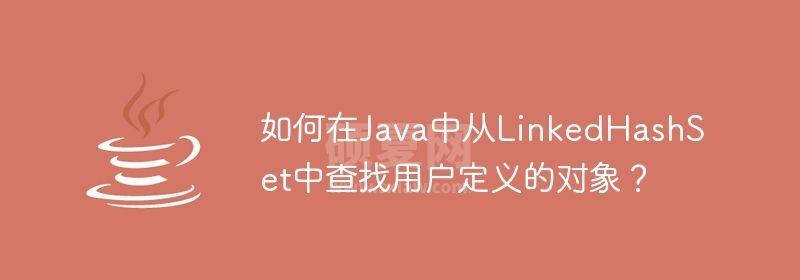如何在Java中从LinkedHashSet中查找用户定义的对象?

LinkedHashSet是Java Collection Framework的一个类,它实现了Set接口并扩展了HashSet类。它是一种链表类型的集合类。它按照插入的顺序存储和返回对象,因此不允许重复的对象。在本文中,我们将使用内置方法'contains()'从LinkedHashSet中查找用户定义的对象。用户定义的对象是通过构造函数创建的。
Java Program to get User-Defined Objects from LinkedHashSet
让我们简要介绍一下我们在示例程序中将使用的两个重要的内置方法。
add()
它接受一个参数并将其添加到集合的末尾。它与LinkedHashSet类的实例一起使用。
语法
nameOfobject.add(argument)
Here, argument signifies the value that we are going to store in the set.
contains()
It accepts an instance of LinkedHashSet class and checks whether the passed instance is available in the set or not. If the set contains that instance then it returns true otherwise false. Its return type is Boolean.
语法
nameOfobject.contains(Object)
Here,
Object 表示我们需要验证的对象的名称
nameOfobject signifies the object of that class which conatins all the collections.
Example 1
The following example illustrates how we can use contains() method to find the user-defined objects from a LinkedHashSet collection.
Approach
首先,定义一个名为 'LinkHset' 的类,在类内部声明两个变量,并定义一个构造函数,该构造函数带有两个参数 'item' 和 'price',分别为字符串和整数类型。
在main方法中,创建一些'LinkHset'类的实例。然后,声明一个LinkedHashSet的集合,并将用户定义的对象放入该集合中
Now, use the 'contains()' method to check whether the specified object is available or not.
import java.util.*;
public class LinkHset {
String item;
int price;
LinkHset(String item, int price) { // constructor
// this keyword shows these variables belong to constructor
this.item = item;
this.price = price;
}
public static void main(String[] args) {
// defining the objects
LinkHset col1 = new LinkHset("TShirt", 59);
LinkHset col2 = new LinkHset("Trouser", 60);
LinkHset col3 = new LinkHset("Shirt", 45);
LinkHset col4 = new LinkHset("Watch", 230);
LinkHset col5 = new LinkHset("Shoes", 55);
// Declaring collection of LinkedHashSet
LinkedHashSet<LinkHset> linkHcollection = new
LinkedHashSet<LinkHset>();
// Adding the user-defined objects to the collection
linkHcollection.add(col1);
linkHcollection.add(col2);
linkHcollection.add(col3);
linkHcollection.add(col4);
linkHcollection.add(col5);
// to print the all objects
for (LinkHset print : linkHcollection) {
System.out.println("Item: " + print.item + ", " + "Price: "
+ print.price);
}
// to find a specified objects
if(linkHcollection.contains(col5)) {
System.out.println("Set contains the specified collection: "
+ col5.item);
} else {
System.out.println("Sorry! couldn't find the object");
}
}
}
输出
Item: TShirt, Price: 59 Item: Trouser, Price: 60 Item: Shirt, Price: 45 Item: Watch, Price: 230 Item: Shoes, Price: 55 Set contains the specified collection: Shoes
Example 2
的中文翻译为:示例2
在下面的示例中,我们将使用contains()方法和迭代器来从LinkedHashSet集合中查找用户定义的方法。
import java.util.*;
public class LinkHset {
String item;
int price;
LinkHset(String item, int price) { // constructor
// this keyword shows these variables belong to constructor
this.item = item;
this.price = price;
}
public static void main(String[] args) {
// defining the objects
LinkHset col1 = new LinkHset("TShirt", 59);
LinkHset col2 = new LinkHset("Trouser", 60);
LinkHset col3 = new LinkHset("Shirt", 45);
LinkHset col4 = new LinkHset("Watch", 230);
LinkHset col5 = new LinkHset("Shoes", 55);
// Declaring collection of LinkedHashSet
LinkedHashSet<LinkHset> linkHcollection = new LinkedHashSet<
LinkHset>();
// Adding the user-defined objects to the collection
linkHcollection.add(col1);
linkHcollection.add(col2);
linkHcollection.add(col3);
linkHcollection.add(col4);
linkHcollection.add(col5);
// creating iterator interface to iterate through objects
Iterator<LinkHset> itr = linkHcollection.iterator();
while (itr.hasNext()) {
// to print the specified object only
if(linkHcollection.contains(col5)) {
System.out.println("Item: " + col5.item + ", " +
"Price: " + col5.price);
break;
} else {
System.out.println("Sorry! couldn't find the object");
break;
}
}
}
}
输出
Item: Shoes, Price: 55
结论
我们通过介绍实现Set接口并扩展HashSet类的LinkedHashSet类来开始这篇文章。在下一节中,我们讨论了它的内置方法'add()'和'contains()',这些方法帮助我们从LinkedHashSet中获取用户定义的对象
以上就是如何在Java中从LinkedHashSet中查找用户定义的对象?的详细内容,更多请关注其它相关文章!
